
Why Discounting Is Bad For Your Brand (And What To Do Instead)
When it comes to incentivizing customers, it's easy to default to using a price or percentage discount. While this strategy may boost your sales numbers, it comes with some serious tradeoffs.
Special Note: This article was inspired by an episode of our podcast, Drive & Convert. We go into much more detail on discounting here than we did on the show, but you might enjoy listening to the original conversation and subscribing to receive future episodes.
Discounting seems like a no-brainer way to increase site sales. You certainly don’t have to go far to find this tactic.
The prevalence of discounting implies this is an effective way to convert prospects into customers.
But here’s the truth:
While discounting feels like a good way to improve your conversion rate and increase sales, it’s actually draining your margins and tarnishing your brand.
The fact is, discounting is all over ecommerce because it’s the easy button — not because it’s the best way to convert customers.
Think of discounts as reaching for fast food every time you’re hungry. Over 35% of Americans (roughly 85 million) do this on any given day.
Yet, you don’t have to be a nutrition expert to know regular fast food is bad for you. Sure, it’s convenient, effective (it curbs your hunger), and tastes good. But all this is deceiving; while you’re checking the box for short-term needs, you’re damaging your long term health. Worse, if fast food becomes a habit, that habit will put you in a bad spot down the road.
Discounts are the large fries equivalent for your business.
They are…
- Convenient: You can have them up and running in hours, if not minutes.
- Effective: They often drive a short-term boost in conversion rate and sales.
- Pleasurable: Who doesn’t enjoy seeing a spike on their revenue chart?
But once you start on them, they’re a hard habit to break. And they’re seriously damaging to your business’s long term health.
How ecommerce brands SHOULD think about discounts
First, a quick clarification. We’re not saying, “never have a sale again.” Rather, we’re saying it’s better to incentivize purchases by increasing the value your customer receives versus reducing the cost of your goods.
Here’s what I mean:
Leading with price vs. value: the difference between discount pricing and promotions
The difference between discounts and promotions is more than semantics:
- Discounting refers to direct dollar discounts or taking a percentage off your price. Discounts encourage the customer to look at price as the main (perhaps even the only) influence on their decision. Think a “10% off your first order when you sign up here” popup, such as the one Artifact Uprising employs:

- Promotions are anything other than slashing the price. Promotions offer additional value to the customers — something they wouldn’t otherwise receive. Done well, this incentive can be more compelling than saving a few dollars. Think volume and loyalty-based perks that gift “something extra.” For example, the way Supply offers a free year of blades with a full-price purchase of their razor…plus free shipping and returns (talk about building trust and busting objections!):
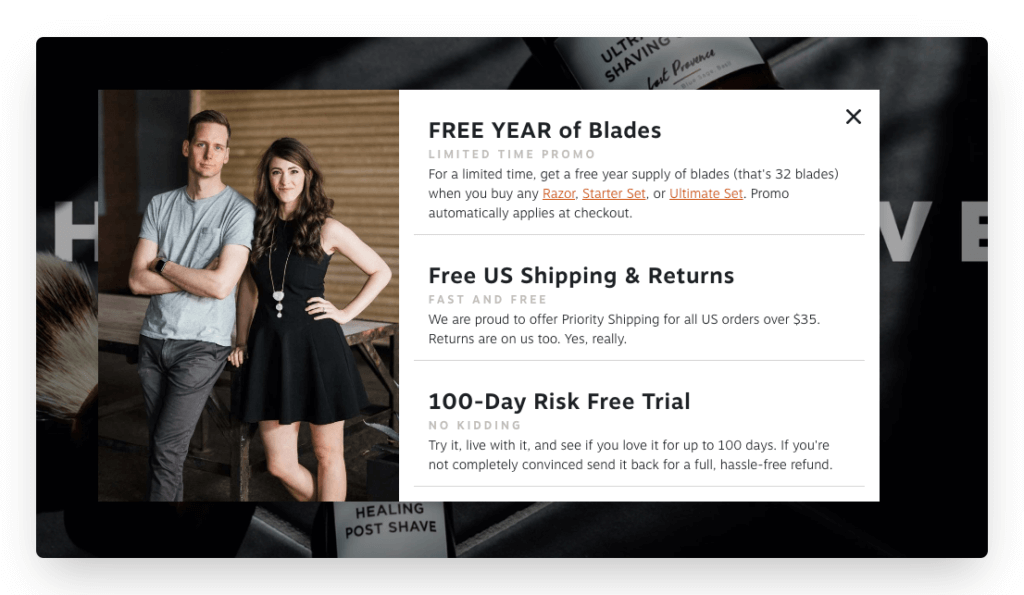
Both promotions and discounts have a similar, two-fold goal: prompt the customer to take action and create urgency that motivates customers to act right now.
But discounting leads with price and scoring a deal, whereas promotions (done well) lead with the value of your product. There’s a big psychological difference for your customers, which means there’s a big difference for your brand and revenue, too.
We’ll get into promotion options later on. For now, let’s look at the long term effects discounts have on ecommerce brands.
Enjoying this article?
Subscribe to our newsletter, Good Question, to get insights like this sent straight to your inbox every week.
Six painful, long term effects of discounting your products
Note that none of the effects below are short-term. These aren’t surface-level pains. They’re not like the headache you get from staring at a computer screen all day — they can’t be fixed with an Advil, glass of wine, and good book.
Rather, they’re the latent pains. They start off imperceptible, but they grow into something that devastates your brand. They’re like the herniated disk (think headache x100) you get from years of poor posture at your desk — insidious, painful, and expensive.
They’re also widespread: they impact your customers, reputation, and your financial health.
Financial Effects
1. Draining your margins
Discounts hack into your margins and reduce your total revenue. You bring in less profit compared to other incentives such as a free gift with purchase or free shipping over a certain threshold.
Need proof?
Profitwell’s Patrick Campbell dug into data from 4,200 subscription ecommerce brands and found higher discounts at purchase correlate with:
- Lower customer lifetime value
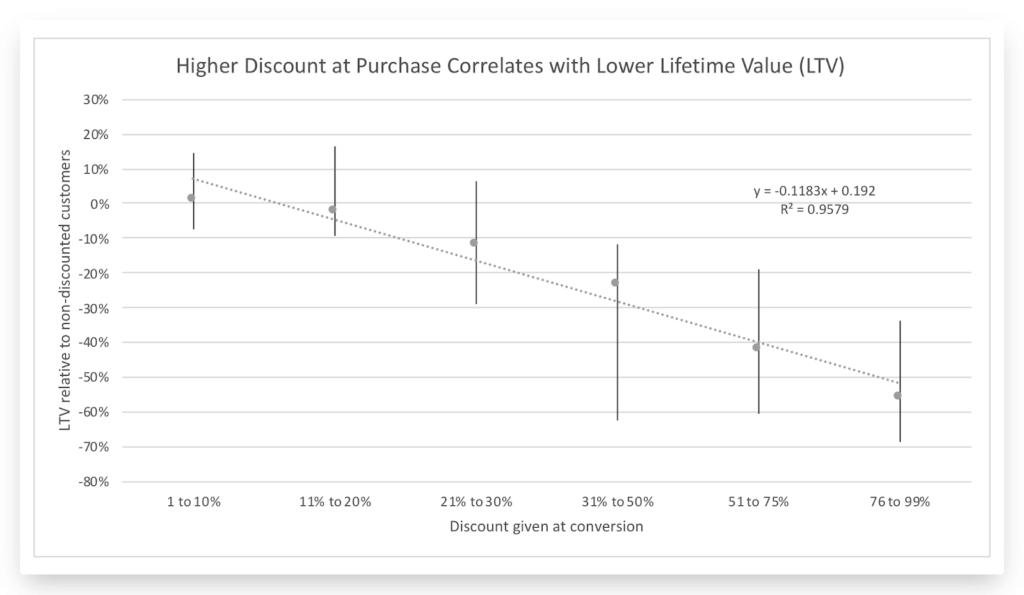
- Lower satisfaction scores
- Higher revenue churn

Whereas promotions such as a free gift with purchase correlated with higher lifetime value compared to percentage discounts.
Customer Effects
2. Training customers to expect (and wait for) steep discounts
Kohl’s always has a sale going on, and it’s usually between 10 and 40% off. But over time, these frequent discounts desensitize customers to the thrill of a deal.
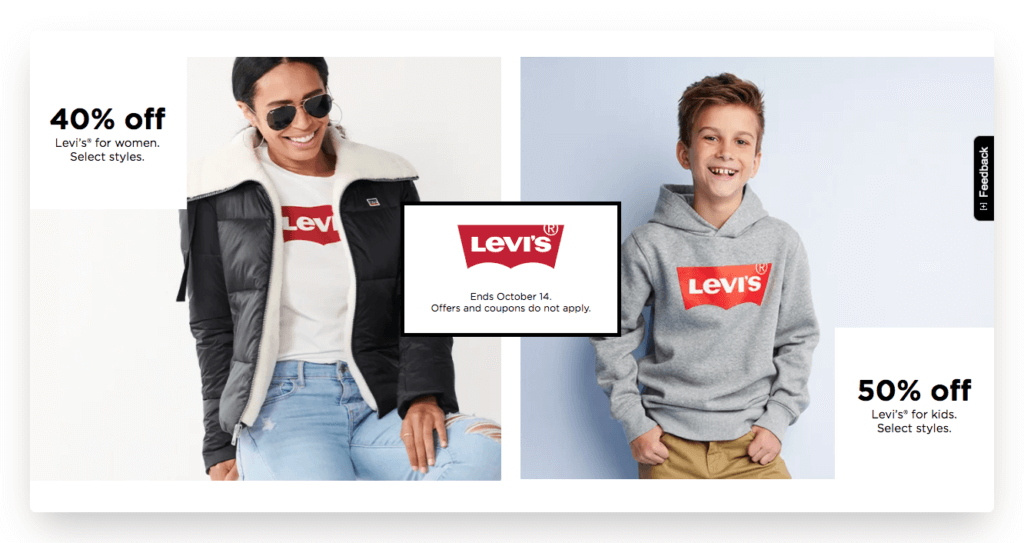
Customers begin ignoring the 10% and 20% off sales and hold out for 40% off sales. This means when you run frequent discounts, you actually work against the very thing you’re trying to do. Instead of prompting action and urgency, you train customers to sit back and wait.
True, discounts work the first time because folks don’t want to miss the deal. But when you get on the “hamster wheel” of discounts, you start creating fake urgency. When there’s always another deal coming right behind the current deal, the urgency evaporates.
Think about it: when was the last time you paid full price for an item from Michaels or Bed Bath and Beyond?
Sometimes, this fake urgency comes in a more malicious form — think countdown timers for sales/offers that don’t actually disappear if you miss the window. For example, when we reviewed Native Deodorant (check out the podcast episode), we discovered a countdown timer on their site. Only, when you waited it out, you could still sign up for the giveaway.
That kind of fake scarcity/urgency is gross, erodes trust, and damages your reputation.

Another fake urgency tactic shows up on checkout screens. Think an “only 3 items left in stock!” or a “this price is only good for 15 minutes” memo with a countdown timer.

If that scarcity is true, it can be crazy effective. But if it’s false, it’s gross and erodes customer trust. There are much healthier ways to drive genuine urgency.
3. Attracting less-than-ideal customers
Brands attract 7 types of customers:
- Just Looking
- Bargain Hunters
- Buyers
- Researchers
- New Customers
- Dissatisfied Customers
- The Loyal Crowd
While it’s worth looking at how you can convert all types of customers, discounts disproportionately attract the bargain hunter crowd — the “no discount, no purchase” customers who only buy when there’s a substantial sale.
When you consistently use discounts to incentivize purchases, you make “Bargain Hunters” a larger portion of your customer base. These aren’t bad customers per se, but they’re less profitable than the “The Loyal Crowd.” So, the more you discount and attract “Bargain Hunters,” the more you cut into revenue.
When you train customers to expect discounts and disproportionately attract coupon-clippers, you fast-track your transition to a deal buster brand. You condition customers to think, “this product really isn’t worth what they usually charge.” And that’s a hard perception to reverse.
4. Lowering customers’ perception of quality
As Jon noted on a recent episode of our Drive & Convert podcast, once you’re a discount brand in the eyes of the consumer, you’re forever going to be a discount brand. It’s just not something you can easily recover from.
Other Long-term Effects
5. Falling into a race to the bottom
When you compete on price, you enter your brand in a race to the bottom. Because price cuts are the easiest thing for you to implement, they are also the easiest thing for your competitors to match. You do 10%, competitors do 15%; you do 20%, they do 25%.
While you and your competitor might both win a pricing battle here and there, you’ll both lose the discount war.
Keep in mind:
Other brands are discounting, but that doesn’t mean you have to copy them. You’ve no idea how that tactic is working out for them behind the scenes. They may have higher top-line revenue, but there’s a good chance their profitability isn’t as healthy as yours. And the company with a better profit margin almost always wins.
6. Putting a bucket under a leaky pipe
Discounts do provide a temporary lift in revenue, which is why brands reach for them. But they’re a short term fix.
If you’re losing customers because of poor traffic quality, bad copywriting, confusing site structure, or a lack of social proof, a discount might help you catch some of those dripping dollars. But discounting will never address the root cause — a bucket can’t plug holes in the sales funnel.
Discounts aren’t ALWAYS bad. Here are two scenarios where we recommend using them
As a general rule, discounts are harmful to your brand. But there are two exceptions where it makes sense.
1. Securing a high lifetime value customer with a breakeven sale
If you discount an initial sale to secure a high lifetime value customer at a breakeven price, that’s a win. This customer will more than make up for it down the road.
For example, let’s say you sell a product that has frequent repeat purchasers. If your customers stick around for at least a few months, then, on average, you can afford to break even or take a slight loss on the initial sale. Over time, you’ll come out way ahead.
Look at Quip:
Quip sells electric toothbrushes and flossers. They’re confident in their product and they know their customer lifetime value, so they include your first replacement brush for free. This gets new customers into a high-value replenishment plan quickly.

Quip takes the financial loss on the initial replacement just fine because most customers continue using their product. Over the long haul, the automatic replenishment plan generates above and beyond the value needed to cover the initial loss.
2. A true, infrequent offer once or twice a year
The other time discounting your prices is acceptable is when you run a true, infrequent (less than 3x per year) offer.
For example, Bare Performance Nutrition only runs two sales a year. The founder, Nick Bare, explains, “We pride ourselves on not being a huge discount brand and only run two sales each year — Black Friday and 4th of July (each being 20% off site-wide).” Fun fact: Bare is a veteran, so the July sale is tied directly to his brand’s origins.
In scenarios like this, you’re introducing genuine urgency at a frequency that won’t train your customers to wait for a deal. And that’s why it works.
Caveat: If you go this route, factor in your customer’s expectations when you select your 1-2 yearly offers. Depending on your product, customers may expect discounts on Black Friday, Mother’s/Father’s Day, Valentine’s Day, or other notable times of the year. In these isolated scenarios, not having a discount on expected days can make it hard to compete or hit your goals.
Real world example: using promotions instead of price discounts
We’ve seen promotions work firsthand. Recently, one of our Consumer Packaged Goods (CPG) clients launched a limited edition product with a seasonal flavor and a reduced price.
So, this brand paired a reduced cost (not a discounted) item with a genuine urgency play (limited seasonal release). It was a smart move.
Here’s what happened:
- Average order value decreased slightly
- # of transitions went up 5%
- Average # of products per transaction increased
- Gross revenue increased by 9%
- Conversation rate increased by 0.5%
Overall, between 10 and 15% of total revenue for the quarter came from this limited release product. Other similar experiments you could run include:
- A bundle that includes a seasonal item at a reduced price
- A reduced price on a seasonal item when the cart value exceeds a certain amount
- A “free seasonal item with purchase” offer when the customer hits a minimum cart value or adds specific products to their cart
So, how do you move off discount pricing and start implementing healthier promotions like these?
How to drop the scissors and move away from price cuts
When you’re used to running discounts, stepping away from them isn’t easy. Especially when it feels like they’re working, and especially when you’re reporting decent numbers up the chain. From that perspective, nixing discounts feels risky — even when you know it’s a smart long term play.
We get that, and we’re not recommending you cut your discounts cold turkey.
Here are a few things you can do right away to take a healthier approach to discounts in the near-term, while also taking steps to wean yourself off of discounting over the long-term.
What to do right away: improve your existing discounts
1. Have one-time use discount codes
One time use discount codes help keep your brand off sites that aggregate coupons, like the one in the image below.
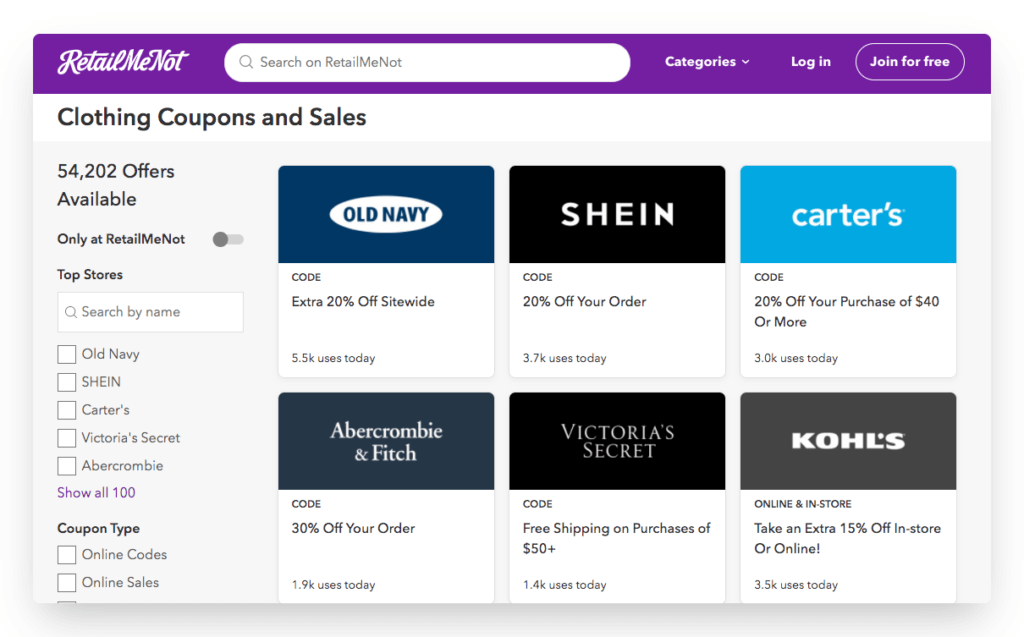
Instead of having a universal discount code such as “FALL20,” use an ID that’s unique to each customer and only works once.
2. Use link-based discounts
If you’re emailing out discounts, you can ditch the promo code altogether and opt for a link-based coupon. In this scenario, the customer doesn’t need to copy and paste a promo code. Rather, you deliver them (via the email link) to a checkout page with the discount already applied in cart.
3. Hide the coupon field during checkout
Many brands show an open coupon field during the checkout process. But our A/B testing shows that, as soon as your customer sees this empty field, they want to fill it in. The implication is the customer isn’t getting the best deal unless they find that code.
Once I see a box like the one below, I’ve left a checkout page plenty of times to hunt down a code:
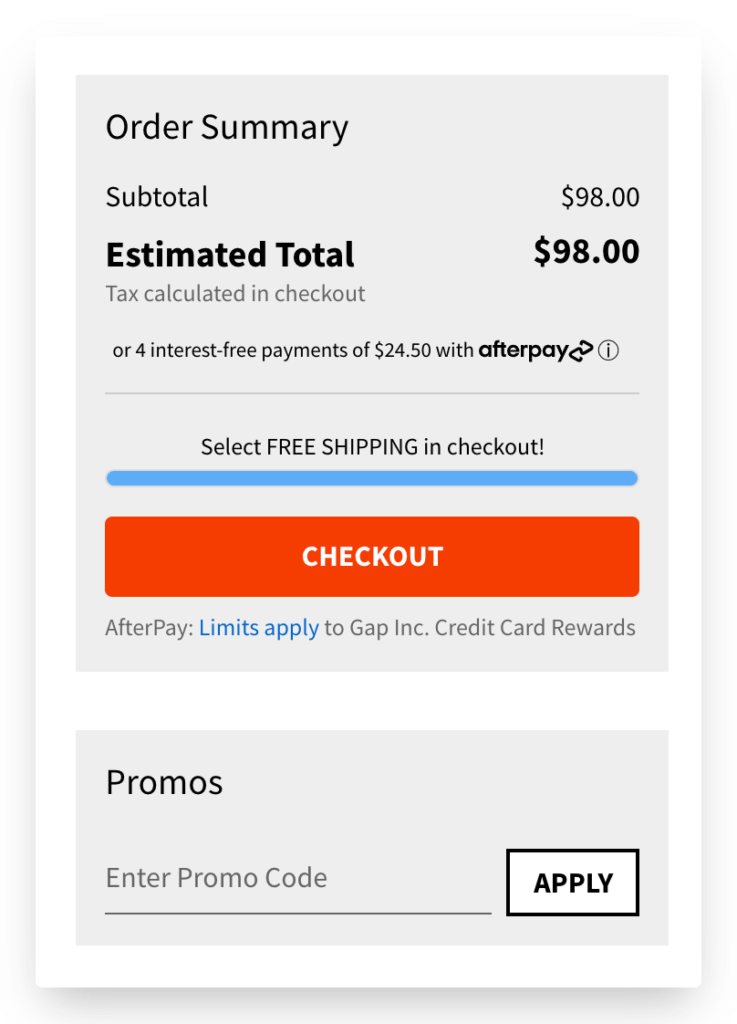
To ward off this behavior (and associated cart abandonment), hide this field by default. You could remove it altogether if you have no active discounts. Or you could display text that says, “Promo code” or “Referral code” like in the Sundays for Dogs example below. In comparison to an open field, this text only expands into a field when a customer clicks it.
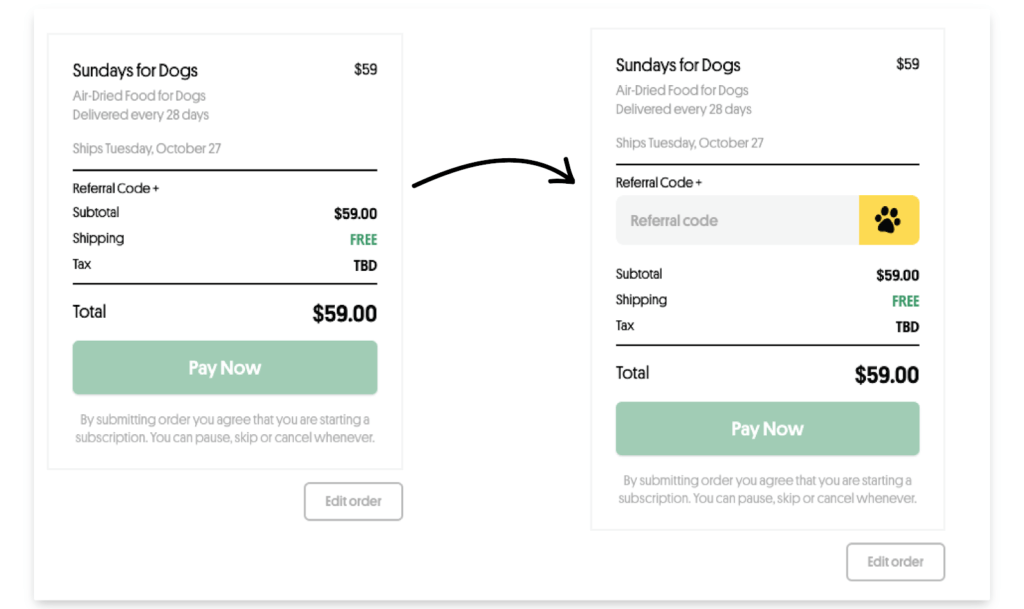
How to play the long game: move toward value-based promotions
To achieve steady, long term growth, you’ll need to move off price-centered discounts and onto value-centered promotions. Here are two ways to start doing that.
Step 1: Review your promotions calendar
Pull out your promotions calendar and look at the next 3-12 months (whatever you have planned). Ask yourself what discounts you have scheduled and which ones you can swap out in favor of value-based promotions. Mark those.
Step 2: Replace a bad habit with a better one.
The best way to cut a bad habit is to replace it with a better one. As habit expert James Clear pointed out, “bad habits address certain needs in your life. And for that reason, it’s better to replace your bad habits with a healthier behavior that addresses that same need.” Otherwise, you’re poised to fall right back where you started. (Think fasting from Hulu only to binge on Netflix.)
So, here are five promotions you can use instead of discounts to prompt action and create healthy urgency:
- Free gift with purchase: Incentivize customers to make an initial purchase by offering them a complimentary gift, the way Thrive Market does in their new customer flow:
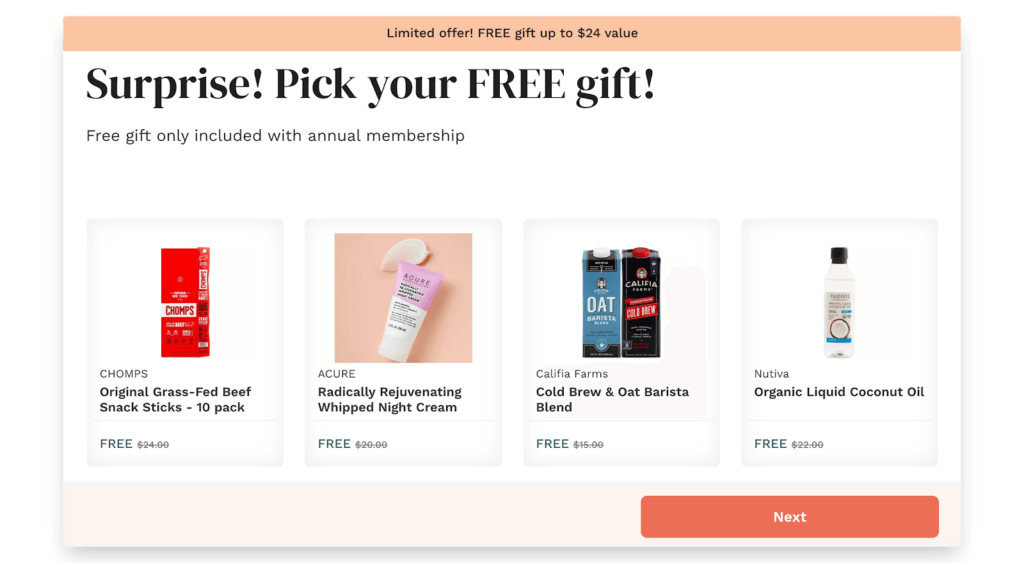
- BOGO: Clear out inventory with a “buy one, get one” offer. You could do buy one, get one half off or buy one, get one free.
- Free shipping: There’s a reason this is a key perk of the Amazon Prime program. And while it’s become a bit of an expectation thanks to Amazon, it’s still a compelling incentive — especially on bulky items, like furniture and mattresses, where shipping is usually an arm and a leg. Variations like free expedited shipping (e.g. 2-day over 5-day) or free shipping above a certain cart value (to protect your margins) are also effective.
One reason this works is consumers don’t like surprises. In 2020, a whopping 50% of shoppers cite “extra costs too high” (e.g. shipping) as the reason they abandon their cart. Offer free shipping the right way, and you’ll see higher conversions.
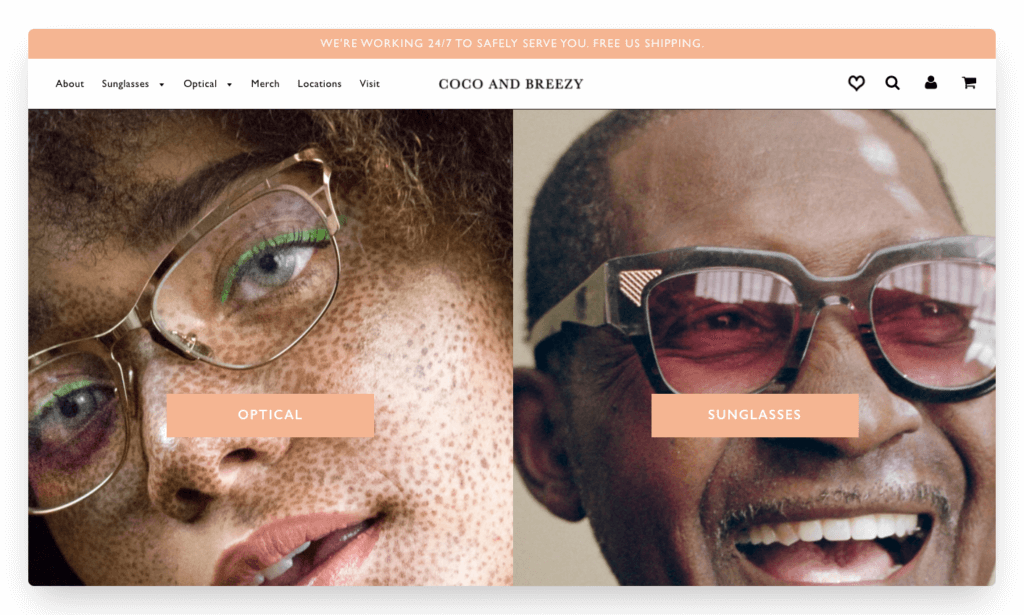
- Free returns: If customers are apprehensive about purchasing certain items, free returns can eliminate the fear of “but what if it doesn’t work out?” While this may increase your return rate, it’ll likely increase customer loyalty as well. Mattress brand Tuft and Needle pairs their free returns with a 100-night trial to persuade customers it’s no big deal if the mattress they choose doesn’t lull them to sleep:

- Loyalty programs: According to a Wirecard survey, 92% of consumers are swayed by rewards some or all of the time. So, reward loyal customers with a set of appealing perks that encourage repeat purchases. For example, how Mack Weldon offers tiered loyalty rewards. Their CEO, Brian Berger, explained to CNBC, “We have a permanent loyalty program. … And that gets us out of the cycle of having to think about promotions and retraining customers in a way we wouldn’t want them to behave.”
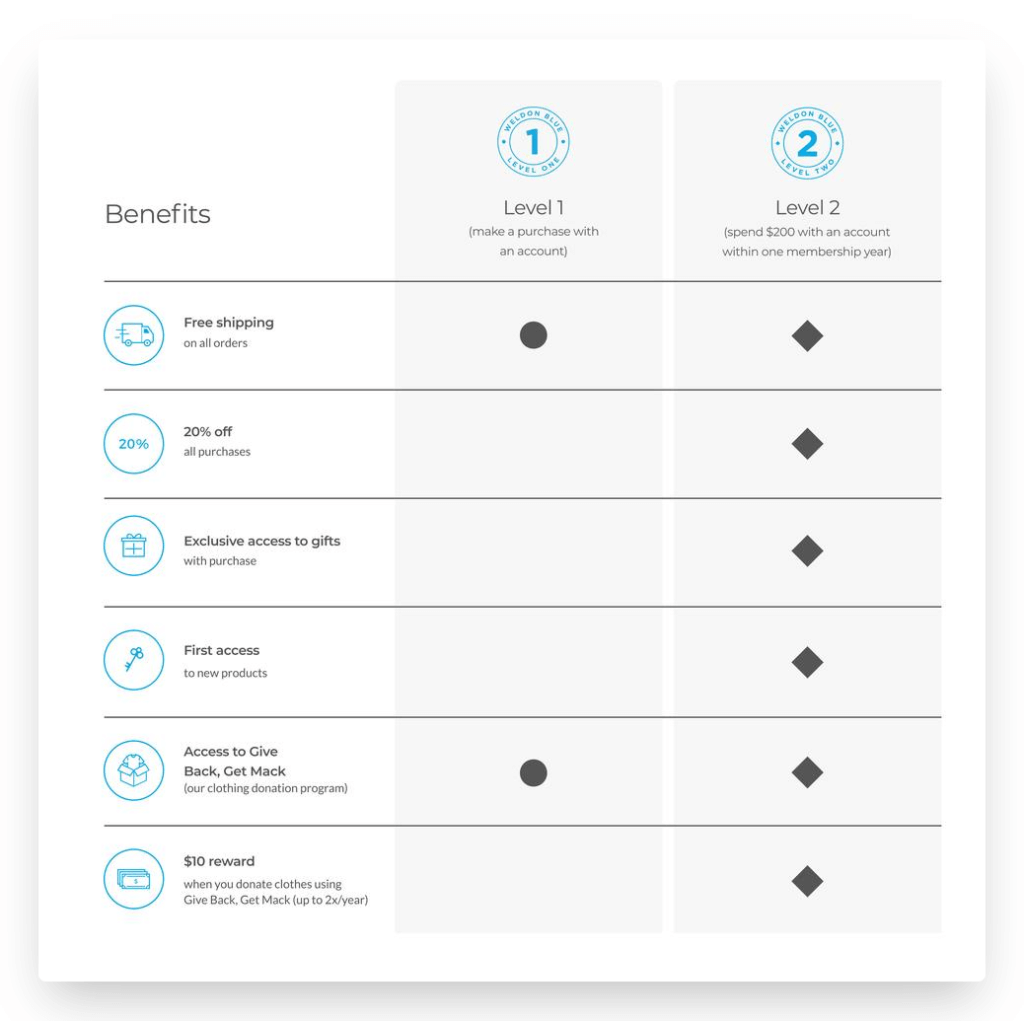
Keep in mind these five options aren’t even close to an exhaustive list. For more alternatives, such as product bundling and bulk promotions, check out these other resources from The Good:
- 78 tactics you can utilize to run winning sales promotions
- 10 tactics to drive ecommerce sales without discounting
- Top 7 ways to increase ecommerce sales (without discounting)
- How to form great limited time offers
You don’t have to discount prices to improve your conversion rates
Discounting isn’t the gold standard of ecommerce. It may seem that way because “everyone else is doing it.” But remember, that’s not because it’s a great business practice — that’s because it’s easy.
Don’t be lazy; get creative with your incentives and lead with value, not price. You’ll improve your margins, strengthen your brand, and best competitors…all without slashing your prices.
Want more insights like this one? Subscribe to our email list. Every Tuesday, you’ll join thousands of ecommerce leaders receiving strategy and tactics around:
- Identifying what your customers want
- Getting site visitors un-stuck
- Improving conversions
- Earning more revenue, customers, and leads
Enjoying this article?
Subscribe to our newsletter, Good Question, to get insights like this sent straight to your inbox every week.

About the Author
Laura Bosco
Laura Bosco is a former Content Marketer at The Good and freelance writer. She helps translate thoughts, opinions, and client experiences into written products that are both entertaining and educational.